Terrorgram: A community built on hate
Telegram’s far-right ecosystem provides a haven
Terrorgram: A community built on hate

Telegram’s far-right ecosystem provides a haven for online hate communities and a gateway to extremist content

A racially motivated attack by a lone gunman left nine dead in the town of Hanau, east of the city of Frankfurt, Germany, on February 19, 2020. Hours after the attack, the shooter’s manifesto and video messages were amplified by right-wing extremist groups on Telegram, amassing thousands of views from users on the encrypted messaging app.
In recent years, Telegram, a point-to-point communications app, has seen an influx of extremist channels using the platform’s “public channel” feature to foster online communities. These range from channels dedicated to sharing “politically incorrect” jokes and memes to more virulent channels explicitly aligned with far-right terror groups. Despite encompassing differing strands of the far-right movement, the channels regularly cross-post and share content related to the manifestos, do-it-yourself weapons designs, and livestream videos of mass shooters, amplifying the content to a large audience of transnational far-right sympathizers on the platform.
In particular, the content related to far-right shooters aims to create a cult of personality around mass shooters venerating them as “saints,” while also encouraging users of these channels to follow their example. Considered within the broader context of a sharp increase in the number of violent incidents carried out by far-right extremists across the West, the use of online messaging apps such as Telegram as a tool to radicalize and enable the next generation of far-right terrorists is a threat that warrants greater public attention.
A community built on hate
After multiple mass shootings in the United States in 2019, major social media platforms enacted a series of measures to address public concerns regarding the misuse of their platforms by far-right extremists. In March 2019, Facebook announced a ban on content related to white nationalism and separatism. In June 2019, YouTube followed suit and announced that it would ban all neo-Nazi material on its platform. In the face of increased scrutiny, right-wing extremists have migrated to alternative platforms, with Telegram, a Russian social media platform, emerging as a favored choice. The popular encrypted messaging app was made by Pavel Turov, a free speech and privacy advocate who also created Russian social media platform VKontakte, which is widely popular among Russian-speaking internet users.
Telegram experienced a surge in far-right users after the notorious online message board 8chan was de-platformed by its domain registrar and web host in August 2019 for its links to three mass shootings in the United States. The U.S.-based outlet Vice analyzed 150 far-right public channels on Telegram and found that more than two-thirds were created in the first eight months of 2019, concluding that not only had white nationalists increased their presence on the platform but that the nature of content shared on these channels had grown increasingly radical and violent over the course of their investigation.
Despite being relatively isolated from mainstream political discourse in comparison to other platforms such as Twitter and WhatsApp, Telegram allows users to participate in end-to-end encrypted messaging with its “group” feature, which is capable of hosting up to 5,000 participants. Additionally, the platform offers a “public channel” feature that allows administrators to host up to 200,000 participants in a single chat, as well as upload an unlimited amount of media and content. Cumulatively, these features have made the app an effective vehicle for malicious users seeking to spread propaganda, exchange tactics, and discuss strategy, as well as potentially orchestrate future attacks.
A many-headed hydra
The extremist public channels on Telegram encompass multiple dimensions of the far-right movement, with some of the most popular channels on the platform amplifying content related to neo-Nazism and white supremacy.
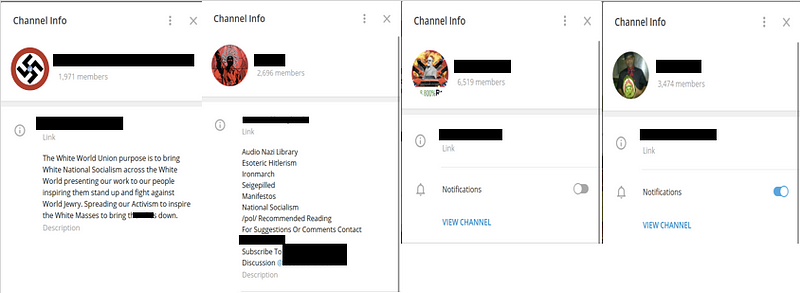
Some channels also serve as online repositories for imagery, texts, and speeches by a diverse range of prominent far-right figures past and present, such as Adolf Hitler, George Lincoln Rockwell (founder of the American Nazi Party), and James Mason, author of the Neo-Nazi SEIGE newsletters.

Other channels focus on promoting anti-Semitism, uploading content aimed at vilifying immigrants and Jewish communities, as well as emphasizing the inherent superiority of Western/European culture and history. One of the fastest growing far-right groups on the platform, with over 8,000 members, aims to “expose” prominent personalities for being of Jewish descent, as well as create an online list of Jewish people critical of white nationalism.
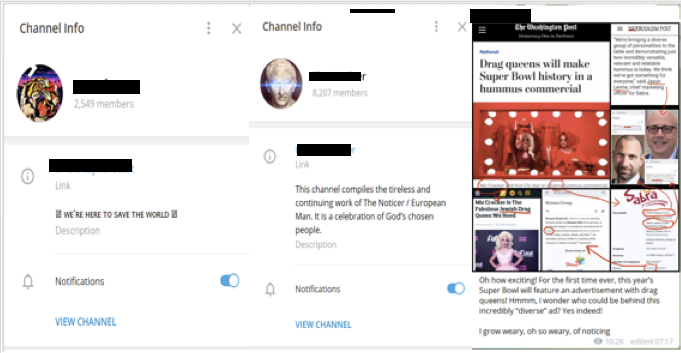
Another subset of channels promotes “Terrorwave” — a right-wing online community that posts hyper-stylized pictures of far-right attacks and violent incidents, using slick aesthetics to make the violence seem more appealing. Many of these groups intersperse links from traditional media outlets with jokes, memes, and propaganda produced by far-right terror groups.
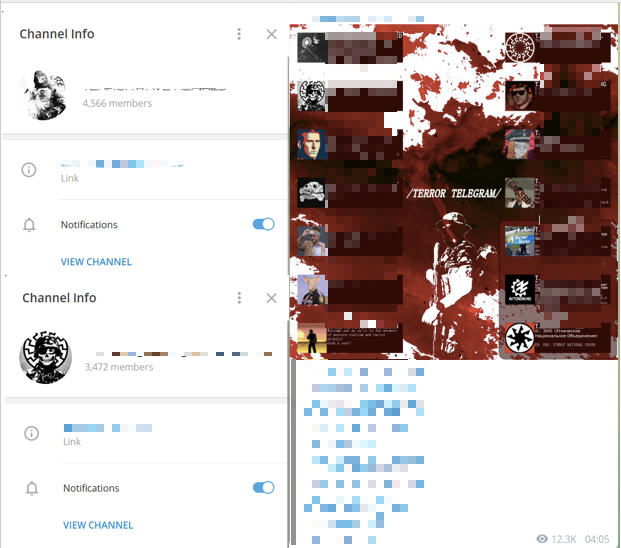

Despite focusing on differing aspects of the far-right movement, many of these groups support a philosophy known as “accelerationism,” which calls on its followers to commit violent incidents targeting politicians, journalists, celebrities, and protected communities in a bid to undermine social stability and hasten the downfall of modern civilization and build a new system based on white supremacy.

Cross-posting content
There is significant interplay among channels in Telegram’s far-right ecosystem: channels catering to differing strands of the far-right movement often cross-post content from other channels belonging to the far-right community on the app, which has the effect of expanding the reach of the cross-posted content to a broader audience. In many cases, public channels that are meant for sharing jokes and memes cross-post content from more radical channels.
In one example, the administrator of the first channel, ostensibly devoted to sharing “jokes and memes,” uploads a series of disparate images before cross-posting another meme from a “terrorwave” channel that references a woman dreaming about Brenton Tarrant, ascribing sainthood to the far-right terrorist responsible for the Christchurch massacre. In comparison to the two preceding posts, the third cross-posted meme experiences a jump in viewership, from 324 views to 1,091 views.

Similarly, a second example provides another demonstration of this behavior, with the content registering an increase in views from 1,293 to 3,921 with the channel administrator noting that despite being “taken from another channel, it hits the nail right in the head.”

This cross-posting behavior lowers the threshold for entry for new users into established far-right extremist channels. Users subscribed to channels focused solely on amplifying news articles and memes may encounter increasingly explicit content that has been cross-posted from other, more radical channels. Over time, exposure to this content may drive users new to Telegram’s far-right ecosystem further toward its more extremist edges.
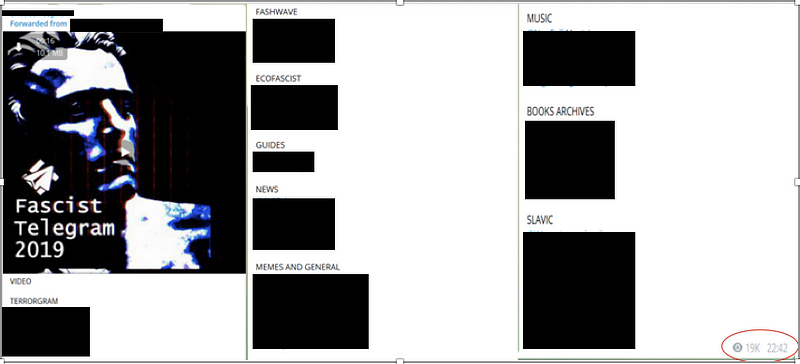
Propaganda of the deed
By turning to online technologies to broadcast their efforts, far-right extremists are employing a tactic known as “propaganda of the deed.” This tactic calls for individuals to commit political acts to establish a model for others and provoke further political unrest. Far-right attackers are increasingly employing tools of the digital era, such as recorded livestreams, memes, and political manifestos replete with cryptic references to far-right online subculture to gain infamy and spread their ideology among a large audience of like-minded users.
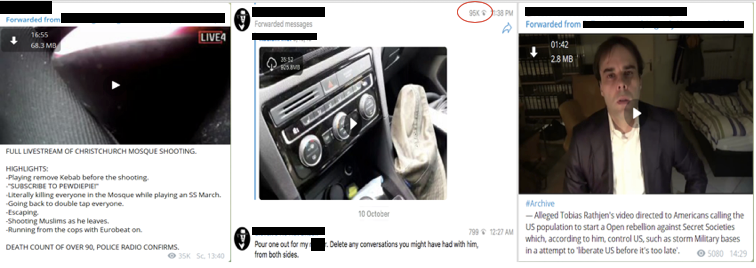
In turn, online communities devoted to far-right extremism use public channels on Telegram to further amplify the political writings and videos of mass shooters, which accumulate thousands of views and help the channels further grow their audience on the messaging app.
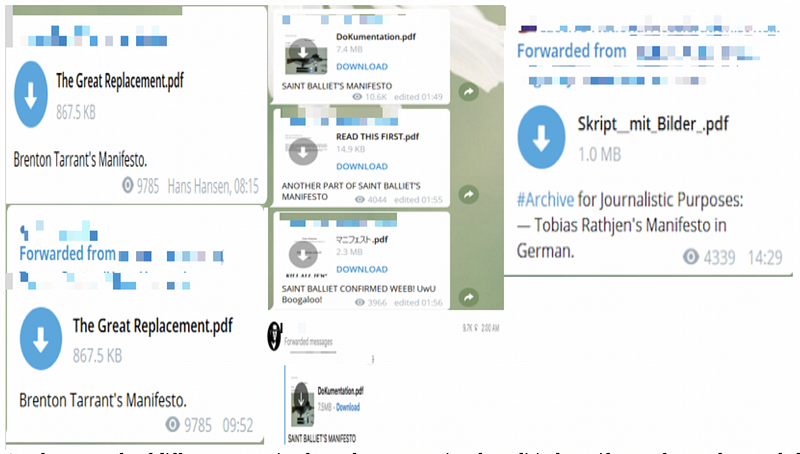
The channels also amplify content that venerate prominent far-right terrorists as having attained “sainthood” for their crimes, while also sharing content and memes referencing the assailants and gloating over the horrific nature of the killings. As part of this process, the channels regularly amplify images of the attackers weapons, attire, and writings in a bid to imbue them with a symbolic quality. This imagery aimed at deifying mass shooters is subsequently deployed as a steady stream of content via the community of far-right channels, usually alongside messages exhorting other users to follow suit.
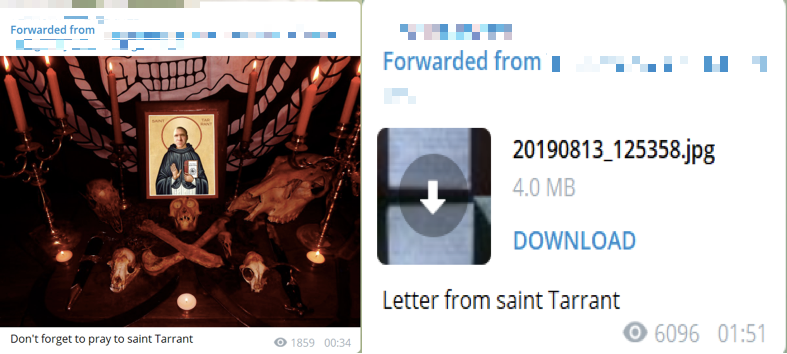
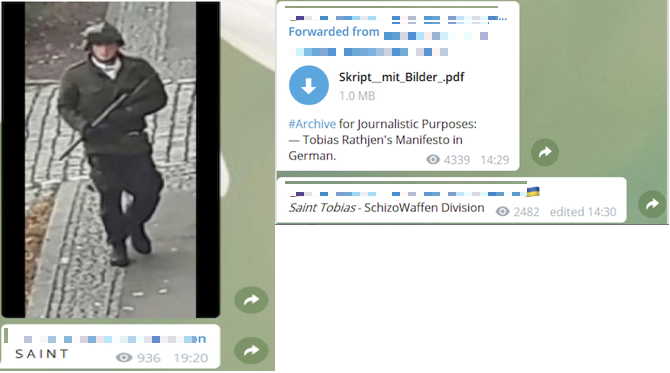
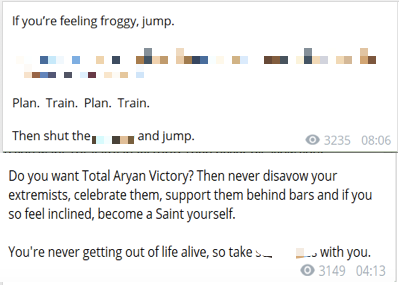
A rising tide of hive terrorism
The Hanau shooting represented the latest in a string of high-profile domestic terror attacks across the West carried out by lone gunmen professing a radically militant form of anti-semitic and European/Western chauvinist worldview. According to the 2019 Global Terrorism Index, the past five years have seen a more than threefold increase in the number of incidents related to far-right extremism in Western Europe, North America, and Oceania, with the number of deaths related to far-right violence increasing from 11 in 2017 to 77 by the end of September 2019.
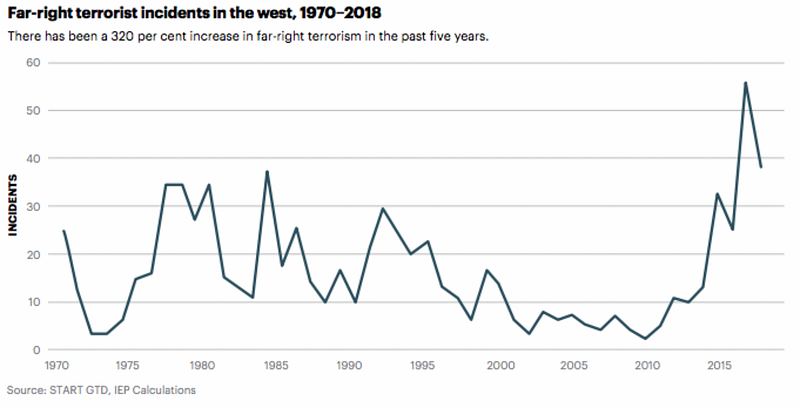

In an interview with The Economist, D. Koehler, a German scholar researching the phenomenon of these “lone wolf” attacks, also called “hive terrorism,” asserted that this development has further complicated the efforts of law enforcement agencies to counter far-right violence. As a result of the wide proliferation of extremist content online, the barrier to entry into the far-right ecosystem has lowered to a degree that is “practically impossible to predict when someone will go from wishing others dead to actually killing them.” Extremists have learned how to exploit features of particular digital platforms, such as Telegram, to transmit information, grievances, and virulent propaganda to a large and transnational user base.
Ayushman Kaul is a Research Assistant, South Asia, with the Digital Forensic Research Lab.
Follow along for more in-depth analysis from our #DigitalSherlocks.

